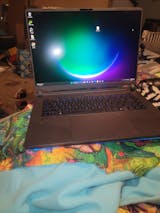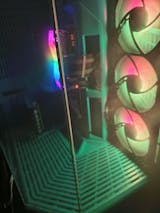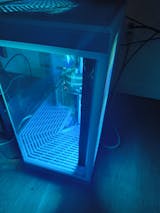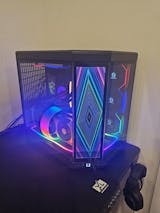At one point in PC time, liquid cooling was considered pure folly. Few enthusiasts could afford to take their chances with liquid-cooling hardware or components that weren’t necessarily compatible with a silicon environment. Original liquid-cooling hardware consisted of plumbing fixtures and hand-milled water blocks, all made in the hope of creating a watertight system that never leaked and could efficiently transfer heat away from core components. Back then, the average PC enthusiast wasn’t very concerned with how a PC looked. Today, liquid cooling has become a bonafide trend in custom builds. In this guide, we dive into the perks, aesthetics, and necessary components of water cooling, so you can decide whether your custom PC can benefit from the little law of thermal and fluid mechanics.
Air Cooling vs. Water Cooling
Most modern central processing units come with stock air cooling solutions, but hardcore gamers look to aftermarket air cooling solutions for superior heat dissipation. Aftermarket air coolers employ copper base plates to dissipate heat through pipes. With the help of high-performance fans, these air coolers keep CPUs running at optimal temperatures. However, many of the aftermarket air coolers on the market are quite large and loud. Water cooling solutions are able to transfer heat much more efficiently than air, and they also allow your PC to run quietly. Fan control correlates with noise control and reduction.
Aesthetics of Liquid Cooling
PC enthusiasts pay much more attention to the look of their custom builds than ever before. Water cooling allows you to enhance the look of your build with braided cables, windowed side panels, LED lighting, and other features. With an all-in-one water cooler, you can save time and energy, as well as the peace of mind a warranty provides. Another option includes soft tubing loop made of neoprene, rubber, silicone, PVC or some other special compound. Tubing for liquid cooling is designed to withstand long periods of time without any deformation, degradation, or discoloration.
One of the most popular alternatives to soft tubing is hard tubing. Made from either acrylic plexiglass or polyethylene terephthalate (PETG), this kind of tubing can create an entirely different look by utilizing straight lines and angles. If you’re looking for a clean and organized look, look no further than copper tubing. Copper tubes can be plated with nickel to achieve a more sophisticated look.
Now that you have a basic understanding of tubing requirements, you must also consider investing in a quality case, radiator, CPU block, GPU block, GPU backplate, memory block, reservoir, pump, compression fittings, angled fittings, bulkhead fittings, stop valves, coolant, and fans. Your CPU block must be compatible with the chip you want to cool. The fittings you choose will depend on the type of tubing you decide to use. Last but not least, you need to consider how you plan to output all that heat. Radiators are the ultimate solution, and you will need to take a closer look at fins per inch (FPI) to determine how much static pressure you will need to effectively move cool air through the radiator.
Finding the components you need is easy, and then you can plan your loop to keep hardware cool to your heart’s content. We recommend planning your loop visually to save time in the long run. After choosing the chassis, fittings, and loops, you should organize your cables and prime your loop for operation. Water cooling is an excellent choice for PC gamers that want to build a beautiful but quiet workstation.
Your cart is currently empty.
Start Shopping













